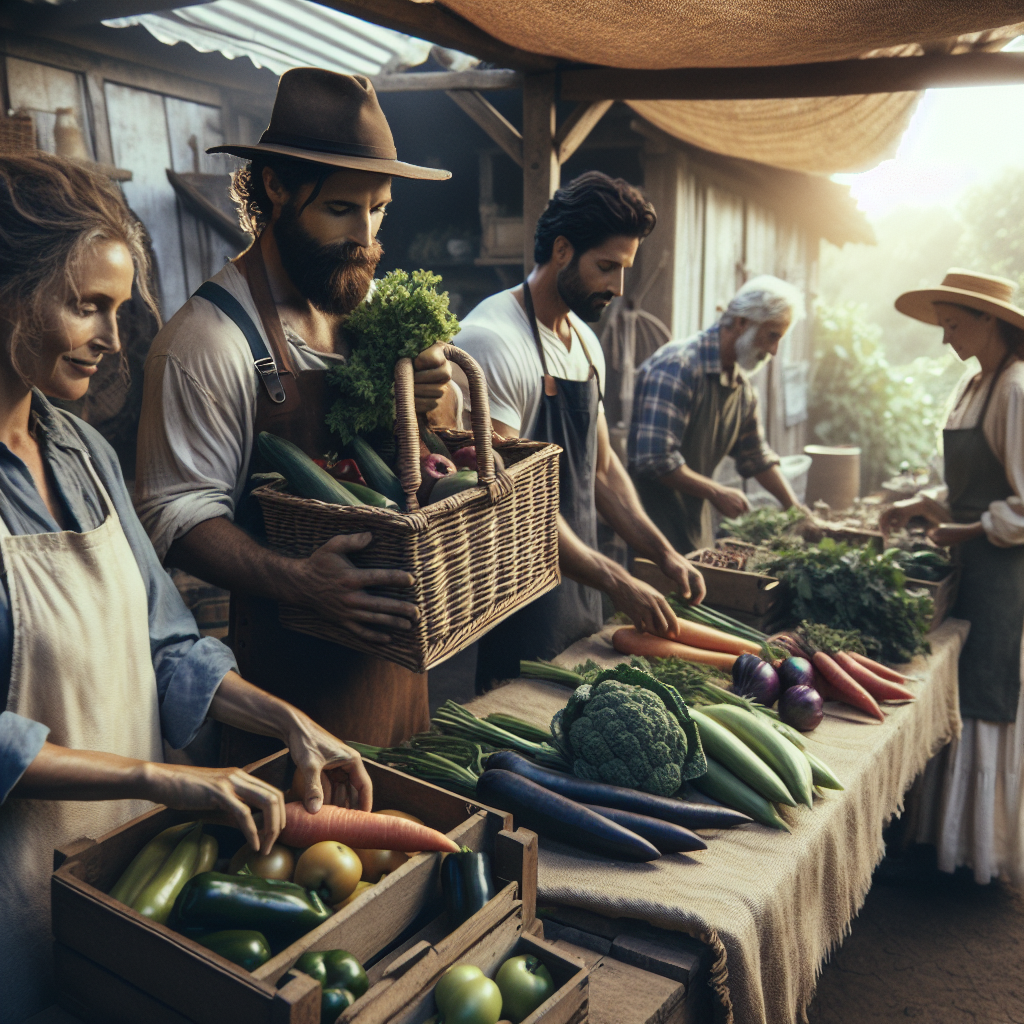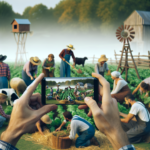Introduction to Direct-to-Consumer Sales in the Agriculture Sector
Ever wondered how the fruits you’re eating or the vegetables you’re cooking get to your doorstep?
The magic behind this is a rapidly evolving business model known as Direct-to-Consumer (DTC) sales. As the name suggests, this model eliminates the traditional middlemen – the resellers, wholesalers, and retailers.
Many of us might ask, what’s the big deal about DTC sales? Well, stick around, and we’ll explore its benefits, challenges, and even provide a brief understanding of its prevalence. The colorful world of DTC sales is exciting.
Did you know, according to the USDA, about 8% of the U.S. farms engage in DTC sales?
So are you ready to explore the thrilling world of DTC sales in the agriculture sector?
Let’s get started!
Table of Contents
Understanding Direct-to-Consumer Sales
Direct-to-Consumer Sales Defined
Direct-to-Consumer (DTC) sales is a business model where producers sell their products directly to end-users.
This eliminates intermediaries like wholesalers, distributors, and retailers. This model allows for more control over pricing, branding, and customer experience.
Benefits of DTC Sales
Selling directly to consumers has several advantages:
- Increased Profit Margins: By cutting out the middlemen, businesses can retain a larger share of the profits.
- Direct Customer Relationships: This model helps in understanding customer preferences and behaviors better.
- Control Over Brand Image: Businesses can maintain a consistent brand message.
- Improved Customer Experience: Direct interaction allows for enhanced customer service.
Popular DTC Sales Channels
Businesses can use multiple channels to reach consumers directly:
- Online Stores: Websites and e-commerce platforms make it easy to sell directly.
- Social Media: Platforms like Instagram and Facebook offer direct sales options.
- Pop-Up Shops: Temporary retail locations can attract new customers.
- Subscription Boxes: Regular delivery of products can secure long-term customers.
Challenges in DTC Sales
While there are benefits, DTC sales come with challenges:
- Logistics Management: Handling shipping and returns can be complex.
- Customer Acquisition Costs: Marketing to individual consumers can be expensive.
- Scalability Issues: Rapid growth may strain resources.
Successful DTC Strategies in Agriculture
In the agriculture industry, DTC sales have grown:
- Farmers Markets: Selling produce directly to customers can be lucrative.
- Community Supported Agriculture (CSA): Customers subscribe for regular produce deliveries.
- Online Farm Stores: Websites allow farmers to sell directly to end-users.
- Food Hubs: These function as collective DTC efforts for multiple small farmers.
For a detailed discussion on the rise and benefits of DTC sales, check out this comprehensive guide on Forbes.
Focus on Farmers: Going Direct-to-Consumer
Explaining the Farmer-to-Consumer Business Model
In the farmer-to-consumer model, farmers make their produce available directly to the end consumer, stepping away from the traditional format of supply to wholesalers and retailers. This pattern of DTC sales within the farm industry has positive impacts on both farmer income and freshness of produce for consumers.
Selling Points for Farmers
This shift in selling strategy benefits farmers significantly:
- Maximize Profits: By eliminating middlemen, farmers can price their products suitably to maximize earnings.
- Feedback Loop: Direct interaction with consumers provides valuable insights on produce preference and quality feedback.
- Brand Buildup: Farmers can craft a favorable brand and market their practices effectively, like organic farming or free-range offerings.
Routes to Reach Consumers
There are numerous ways farmers employ to make their produce reach consumers:
- Farmers’ Markets: These markets are a classic and effective way to reach local customers.
- Farm Stands: Setting up stands near their farm can attract tourists and local residents.
- U-Pick Farms: Offer a unique customer experience where buyers can pick their produce, providing an interactive approach and fresh pick preference.
- Agriculture Apps: Mobile applications can connect farmers directly to consumers for produce delivery.
Potential Roadblocks for Farmers
However, farmer-to-consumer sales do come with potential roadblocks:
- Logistics and Resources: Similar to DTC, managing the packaging, quality, and delivery can be demanding for farmers.
- Insurance implications: Commercial farming activities, like U-Pick farms, may necessitate additional insurance coverage which can be costly.
- Regulatory Compliance: Abiding with local and federal regulations is vital for activities like home deliveries or online agricultural sales
Successful Examples of Farmer-to-Consumer Networks
Many new platforms have emerged to connect farmers directly with consumers:
- CSA Programs: Consumers subscribe to agriculture shares and receive weekly or bi-weekly produce boxes directly from local farms.
- Online Marketplaces: Platforms like FarmLink allow farmers to list produce for consumers to purchase directly.
- Farm Shares: Some farms sell shares of their produce, similar to a stock market concept, and in return, shareholders receive fresh, seasonal produce regularly.
For learning how some farms successfully implemented these strategies, catch the full story on Farmers Weekly.
Understanding Direct-to-Consumer Sales
What Percentage of Farms Sell Directly to Consumers?
In the U.S., the direct-to-consumer (DTC) sales model has seen considerable uptake among farms. According to the USDA, as of the latest available data, about 8% of all U.S. farms engage in DTC sales. This may seem like a small percentage, but it represents a significant shift towards a more direct relationship between farmers and consumers.
Revenue from DTC Sales
Direct-to-consumer sales can be a financially beneficial model for farmers. A USDA report showed that farms with DTC sales often see higher average revenue per acre compared to those that only sell through traditional channels. The ability to set their own prices without intermediary markups greatly contributes to this increased revenue.
DTC vs. Traditional Wholesale
Traditional wholesale channels involve selling produce in bulk to wholesalers or distributors, who then sell to retailers, who finally sell to consumers. Here’s a comparison:
| Direct-to-Consumer (DTC) | Traditional Wholesale | |
|---|---|---|
| Pricing Control | High | Low |
| Customer Interaction | Direct | Indirect |
| Profit Margins | Higher | Lower |
| Marketing Costs | Medium to High | Low |
| Logistical Challenges | High | Low |
Digital Transformation in Agriculture
Digital technology is revolutionizing how farmers can sell their goods. E-commerce platforms, mobile apps, and social media channels provide new avenues for DTC sales.
- E-commerce Platforms: Websites like Shopify or Etsy provide easy-to-use templates for farmers to set up online storefronts.
- Mobile Apps: Applications like Farmigo and Local Line are designed to connect farmers directly with consumers for real-time ordering and delivery.
- Social Media: Instagram and Facebook Shops allow farmers to reach a broader audience and engage directly with consumers.
Sustainable Farming and Consumer Demand
The trend toward direct-to-consumer sales also aligns with growing consumer demand for sustainability and transparency in food sourcing. Consumers are increasingly interested in knowing where their food comes from, how it is grown, and the environmental impact of its production. Farmers who adopt sustainable practices and communicate these efforts directly to consumers can often command a premium price for their products.
Government Support and Grants
Various government programs and grants can assist farmers in transitioning to DTC sales. For example, the USDA offers grants under the Farmers Market Promotion Program (FMPP) to support the development of local markets and provide funding for marketing, logistics, and business planning.
Exploring more about the importance and benefits of direct-to-consumer sales for farmers can provide valuable insights into this growing trend. For more in-depth information, you can refer to this detailed guide on USDA.
Understanding Direct-to-Consumer Sales
Do Farmers Sell Directly to Grocery Stores?
While many farmers engage in direct-to-consumer sales, some also sell directly to grocery stores. This model lies somewhere between traditional wholesale and pure direct-to-consumer channels.
Advantages of Selling Directly to Grocery Stores
Selling directly to grocery stores offers several advantages for farmers:
- Larger Market Reach: Selling through grocery stores allows farmers to reach a broader market that frequents these stores regularly.
- Stable Demand: Grocery stores often have consistent demand, leading to more predictable sales revenue for farmers.
- Less Marketing Effort: Unlike pure DTC sales, selling to grocery stores means less direct marketing effort by the farmers themselves.
Popular Methods for Direct Sales to Grocery Stores
There are various practical ways that farmers sell directly to grocery stores:
- Local and Specialty Stores: Smaller supermarkets or specialty organic stores are more likely to source directly from local farmers for fresh and unique produce.
- Aggregators and Cooperatives: Farmers can join cooperatives that handle the logistics of selling to grocery chains, making the process more manageable.
- Farmer-Owned Brands: Some farmers develop their brands and negotiate shelf space in supermarkets, offering branded products directly to consumers.
Challenges in Direct Sales to Grocery Stores
This model, while beneficial, also comes with challenges:
- Quality Standards: Grocery stores often have stringent quality and packaging standards that must be met.
- Negotiation Power: Small-scale farmers may have less negotiation power compared to larger suppliers, impacting pricing and terms.
- Consistency and Volume: Farmers must consistently supply produce in the required volume, which can be challenging during off-peak seasons.
Technological Solutions in Direct Sales
Technology is playing a vital role in bridging the gap between farmers and grocery stores:
- Supply Chain Software: Tools like HarvestMark help farmers manage their supply chain more efficiently.
- Online Marketplaces: Platforms such as LocalHarvest and Barn2Door facilitate connections between farmers and grocery stores.
- Traceability Systems: Blockchain and other traceability systems help ensure product quality and transparency, which are critical for selling to grocery stores.
Case Studies of Successful Direct Sales to Grocery Stores
- Happy Apples: This family-owned farm supplies its branded apples directly to regional grocery chains, emphasizing quality and freshness.
- Farm Fresh Rhode Island: This initiative connects local farmers with grocery stores, facilitating direct sales and ensuring local produce availability.
- Willow Haven Farm: By partnering with local grocery stores, this farm offers organic vegetables directly to consumers, maintaining the brand’s organic image.
For more insights into the world of direct-to-consumer agricultural sales, including tips and success stories, check out this informative guide on Forbes.
Wrapping Up Direct-to-Consumer Sales
From the reports discussed, it is clear that direct-to-consumer (DTC) sales present an advantageous avenue for producers, particularly farmers, to profitably distribute their produce while also enhancing customer relations.
Eradicating intermediaries provides control over pricing, brand image, and an improved customer experience. With new and inventive DTC sales channels like online stores, social media, pop-up shops, and subscription boxes, reaching consumers is more dynamic than ever.
However, logistical management, customer acquisition expenses, and scalability issues represent significant challenges that producers need to manage through effective strategies.
Frequently Asked Questions – FAQs
What are some benefits of direct-to-consumer sales?
DTC sales provide increased profit margins by cutting middlemen, allow for direct customer relationships, maintain a consistent brand image and enhance the customer experience.
What channels can businesses use for direct-to-consumer sales?
Businesses can use multiple channels including online stores, social media platforms, pop-up shops, and subscription boxes to reach consumers directly.
What are some challenges in direct-to-consumer sales?
Handling shipping and returns, marketing to individual consumers, and rapid growth that may strain resources can pose significant challenges in DTC sales.
How is the agricultural industry benefiting from direct-to-consumer sales?
From selling produce directly at farmers’ markets, through community supported agriculture subscriptions, online farm stores, to food hubs, DTC sales in the agricultural sector have grown immensely, offering lucrative opportunities for farmers.






